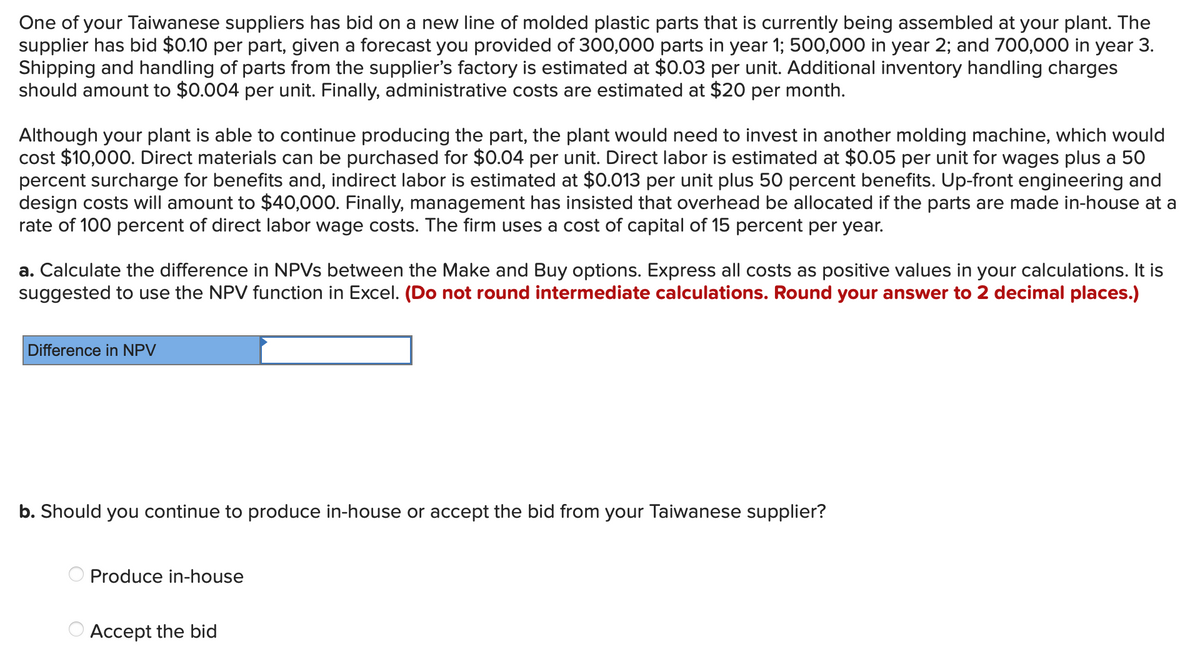One of your Taiwanese suppliers has bid on a new line of molded plastic parts that is currently being assembled at your plant. The supplier has bid $0.10 per part, given a forecast you provided of 300,000 parts in year 1; 500,000 in year 2; and 700,000 in year 3. Shipping and handling of parts from the supplier's factory is estimated at $0.03 per unit. Additional inventory handling charges should amount to $0.004 per unit. Finally, administrative costs are estimated at $20 per month. Although your plant is able to continue producing the part, the plant would need to invest in another molding machine, which would cost $10,000. Direct materials can be purchased for $0.04 per unit. Direct labor is estimated at $0.05 per unit for wages plus a 50 percent surcharge for benefits and, indirect labor is estimated at $0.013 per unit plus 50 percent benefits. Up-front engineering and design costs will amount to $40,000. Finally, management has insisted that overhead be allocated if the parts are made in-house at a rate of 100 percent of direct labor wage costs. The firm uses a cost of capital of 15 percent per year. a. Calculate the difference in NPVs between the Make and Buy options. Express all costs as positive values in your calculations. It is suggested to use the NPV function in Excel. (Do not round intermediate calculations. Round your answer to 2 decimal places.) Difference in NPV b. Should you continue to produce in-house or accept the bid from your Taiwanese supplier? O Produce in-house Accept the bid
One of your Taiwanese suppliers has bid on a new line of molded plastic parts that is currently being assembled at your plant. The supplier has bid $0.10 per part, given a forecast you provided of 300,000 parts in year 1; 500,000 in year 2; and 700,000 in year 3. Shipping and handling of parts from the supplier's factory is estimated at $0.03 per unit. Additional inventory handling charges should amount to $0.004 per unit. Finally, administrative costs are estimated at $20 per month. Although your plant is able to continue producing the part, the plant would need to invest in another molding machine, which would cost $10,000. Direct materials can be purchased for $0.04 per unit. Direct labor is estimated at $0.05 per unit for wages plus a 50 percent surcharge for benefits and, indirect labor is estimated at $0.013 per unit plus 50 percent benefits. Up-front engineering and design costs will amount to $40,000. Finally, management has insisted that overhead be allocated if the parts are made in-house at a rate of 100 percent of direct labor wage costs. The firm uses a cost of capital of 15 percent per year. a. Calculate the difference in NPVs between the Make and Buy options. Express all costs as positive values in your calculations. It is suggested to use the NPV function in Excel. (Do not round intermediate calculations. Round your answer to 2 decimal places.) Difference in NPV b. Should you continue to produce in-house or accept the bid from your Taiwanese supplier? O Produce in-house Accept the bid
Purchasing and Supply Chain Management
6th Edition
ISBN:9781285869681
Author:Robert M. Monczka, Robert B. Handfield, Larry C. Giunipero, James L. Patterson
Publisher:Robert M. Monczka, Robert B. Handfield, Larry C. Giunipero, James L. Patterson
Chapter16: Lean Supply Chain Management
Section: Chapter Questions
Problem 10DQ: The chapter presented various approaches for the control of inventory investment. Discuss three...
Related questions
Question

Transcribed Image Text:One of your Taiwanese suppliers has bid on a new line of molded plastic parts that is currently being assembled at your plant. The
supplier has bid $0.10 per part, given a forecast you provided of 300,000 parts in year 1; 500,000 in year 2; and 700,000 in year 3.
Shipping and handling of parts from the supplier's factory is estimated at $0.03 per unit. Additional inventory handling charges
should amount to $0.004 per unit. Finally, administrative costs are estimated at $20 per month.
Although your plant is able to continue producing the part, the plant would need to invest in another molding machine, which would
cost $10,000. Direct materials can be purchased for $0.04 per unit. Direct labor is estimated at $0.05 per unit for wages plus a 50
percent surcharge for benefits and, indirect labor is estimated at $0.013 per unit plus 50 percent benefits. Up-front engineering and
design costs will amount to $40,000. Finally, management has insisted that overhead be allocated if the parts are made in-house at a
rate of 100 percent of direct labor wage costs. The firm uses a cost of capital of 15 percent per year.
a. Calculate the difference in NPVs between the Make and Buy options. Express all costs as positive values in your calculations. It is
suggested to use the NPV function in Excel. (Do not round intermediate calculations. Round your answer to 2 decimal places.)
Difference in NPV
b. Should you continue to produce in-house or accept the bid from your Taiwanese supplier?
Produce in-house
Accept the bid
Expert Solution
This question has been solved!
Explore an expertly crafted, step-by-step solution for a thorough understanding of key concepts.
This is a popular solution!
Trending now
This is a popular solution!
Step by step
Solved in 3 steps with 2 images

Recommended textbooks for you

Purchasing and Supply Chain Management
Operations Management
ISBN:
9781285869681
Author:
Robert M. Monczka, Robert B. Handfield, Larry C. Giunipero, James L. Patterson
Publisher:
Cengage Learning


Purchasing and Supply Chain Management
Operations Management
ISBN:
9781285869681
Author:
Robert M. Monczka, Robert B. Handfield, Larry C. Giunipero, James L. Patterson
Publisher:
Cengage Learning
